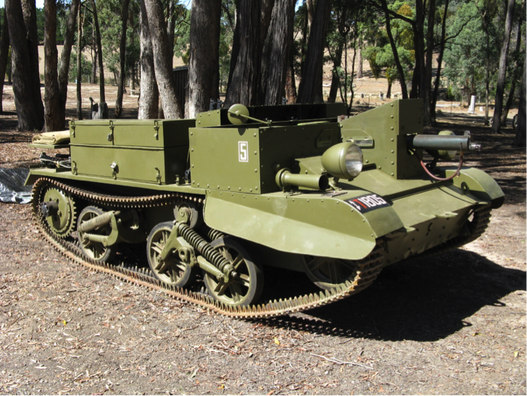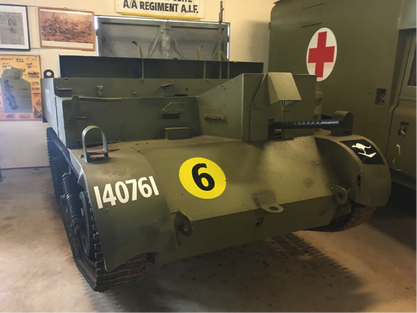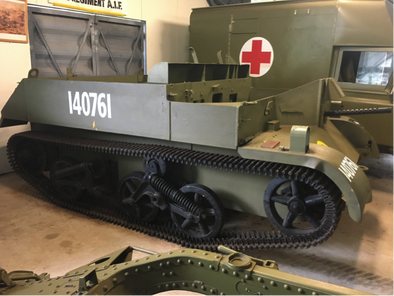|
Darwin war history
Authorby Jared Archibald The Age of the Machines By the end of World War I, machines had changed the face of warfare. Motor lorries replaced animals as a means to transport men and war material to and from the battlefront. Tanks traversed ‘no man’s land’, and aeroplanes brought war to the skies. Machine guns, mortars, and quick-firing artillery were now integral to arsenals, and machines were used to move them quickly and efficiently. This mechanisation of armies continued into the 1930s. The British developed a range of small, tracked, armoured and soft skin vehicles that could be used for a range of purposes including, artillery tractors, machine gun carriers, and armoured observation posts. Australia was closely aligned with British military doctrine and developed its own mechanisation policy that mandated acquiring locally designed and built machines for defence usage. There were two main types of machine gun carriers built in Australia during World War II. Carrier, Machine Gun, Local Pattern, No.1 (LP1) Front view of LP1 carrier restored by Bill O’Reilly. (Source: Jared Archibald collection.) These were the first tracked armoured vehicles built in Australia and, unfortunately, they were not a great success. They were produced in 1940 from plans that borrowed heavily from a single Carrier, Bren, No.2 Mk.1 imported from Britain in 1939. LP1 carriers were built from locally produced bullet-proof plate that was riveted onto an angle iron frame. Ford mechanicals sourced from Canada made up the power train: a side-valve V8 engine that drove through a four-speed crash box to a split-case differential. The power train was situated behind the front compartment and ran down the midline of the carrier. Steering was by track braking only. Two tillers, connected to a pair of hydraulic master cylinders, actuated large external hydraulic cylinders above the differential that, in turn, applied mechanical brakes inside the brake drums. This Australian-designed system proved to be a major problem for this model. The LP1 was armed with a water-cooled Vickers machine gun and a .303 rifle for each crew member. The driver sat on the right side of the front compartment with the gunner on the left. The third crewman sat in the left rear compartment and had a hinged armoured cover he could shelter under if necessary. Equipment and stores were stowed in two long bins mounted on the right side of the carrier, and on a metal shelf fitted across the rear. Ammunition was stored in racks mounted internally. There were various design changes, including: Deleting the rear tow hitch, redesigning the electrical conduit, and changing to stowage bracketry. LP1 carriers were mostly used within Australia for training; however, 50 were transported to the Middle East and used by Australian forces there. Some were also used in the campaign in Greece. They were plagued with problems including engine overheating, excessive and uneven brake wear due to the steering design, and a lack of spare parts. In all, 160 LP1 carriers were built by Victorian Railways at their vast Newport workshops in Melbourne. Although problematic, much was learnt from the experience, and a new design was produced, which corrected many of the inherent faults of this first model. LP1 carriers were declared obsolete in 1942, but many continued in service until the end of the war. Use in the Territory The 7th Military District (7MD as the Northern Territory was known by the Defence Department) was allocated ten LP1 carriers on 27 June 1940. These carriers were loaded onto the Burns Philp ship SS Marella in Melbourne and arrived at Port Darwin some weeks later. They were unloaded on the 31 July and issued to the 2/15 Battalion who were camped at the derelict Vestey’s Meatworks complex at Bullocky Point. These were the first tracked armoured vehicles to come to the NT. They were used extensively for the training of carrier platoons. They ranged widely over the Darwin area. The 2/15 reported that they had severe limitations including “throwing tracks effortlessly, overheating badly, and the third crewman being cooked in the rear compartment”. On the 25 October 1940, these ten carriers were handed over to the 2/25 Battalion, as the 2/15 had been ordered to North Africa. When the 2/25 left Darwin on the 15 February 1941, the carriers remained in Darwin with the 7MD. On the 17 June 1941, the 7MD was directed to send their 10 LP1 carriers to the 3rd Military District (3MD) for rebuild and reissue. It would seem this never occurred, despite a number of requests. On the 27 June 1941, it was recorded that Carrier C-6542 (Hull 42) had clocked up 613 miles after 11 months of use. In June 1942, all LP1 carriers were declared obsolete. The ten 7MD carriers fell into disrepair due to a lack of parts, and the plentiful supply of the much-improved successor to the LP1, the Carrier, Machine Gun, Local Pattern No.2 and 2A (or LP2 or 2A Carrier for short). Two of these ten LP1 carriers survived the war, scrap drives, and abandonment and are undergoing long-term restoration. Carrier, Machine Gun, Local Pattern, No.2 and 2A (LP2 & 2A) Front view of the Darwin Military Museum’s carrier on display at East Point (Source: DMM collection.) The LP2 design was developed from the LP1 but it was a very different machine. It was a still an open top vehicle but now looked similar to the boxy British Universal Carrier. Metal fabrication technology had progressed rapidly, and these carriers were constructed using electric arc welding rather than labour intensive hand riveting. It had a crew of four, and could be armed with a selection of weaponry. Vickers, Bren, Hotchkiss and Lewis machine guns could all be mounted, as well as the Boys anti-tank rifle. The powertrain remained the same. Five large bins were mounted across the rear for the stowage of gear and equipment. Mechanically, the most notable change was to the steering. The new system was purely mechanical and incorporated track displacement steering, as well as track brake steering. For small changes in direction, the steering wheel was turned, offsetting the main bogie axle to the left or right of the midline, warping the tracks, and so steering the carrier. For sharper turns, mechanical linkages applied the brake on one side to slew the machine in the required direction of travel. Early models had various tools mounted externally on the left hull plate, and on the rear apron covering the differential. After around 2700 carriers were built, the design was modified to stow all tools at the rear. The initial interior stowage layout was completely revised after around 3200 carriers had been constructed and this allowed the fitting, if required, of a No. 11 or No. 19 radio set inside the right rear compartment of the hull. The difference between an LP2 and LP2A carrier is not visible externally. LP2s were fitted with a 1938-type rear axle, which had a splined pinion, whereas LP2As were fitted with a 1940-type rear axle with a tapered and keyed pinion. Side view of the Darwin Military Museum’s carrier on display at East Point (Source: DMM collection.) During World War II, the army used these carries extensively in a variety of roles throughout Australia. They were also transported overseas and used in Malaya, the Middle East, New Guinea, and in some of the island campaigns such as Timor and Ambon. They also saw limited use in Japan as part of the British Commonwealth Occupation Forces, and in the Korean War. The LP2 and 2A carriers were the most prolific of the carriers produced in Australia with approximately 4800 being built. They were manufactured between 1941 and 1943 at different factories in four states: Ford Motor Company at Homebush in Sydney, Victorian Railways and Metropolitan Gas Works in Melbourne, South Australian Railways at Islington in Adelaide, and the State Engineering Workshops in Fremantle. Large numbers of subcontractors supplied the parts needed to build and equip each carrier. Use in the Territory Many hundreds of LP2 and 2A carriers saw service in the Top End during World War II. They were used for a range of purposes including: liaison, mortar carrying, forward scouting, and as mobile radio bases. Some were lost during the first Japanese raid on Darwin, as they were in the hold of the USAT Meigs, one of the cargo ships that was sunk. Also, one was destroyed during an air raid on the Darwin RAAF Base on the 25 April 1942. They underwent many modifications over their lifetime in the NT to cope with the rigours of a harsh and unforgiving environment. They were found to be reasonably reliable but needed a high maintenance regimen, and continually suffered from overheating problems, especially in the Wet Season.
Post-war they were sold off at massive surplus equipment sales in Darwin and at Mataranka. Mostly they were purchased for their drivelines which were the same as Ford trucks. Many Blitz trucks and Jailbar Fords have engines and gearboxes in them that originated from carriers. A few were used on stations but were found to be too highly geared and light weight to be bulldozers so were quickly consigned to the salvage dump. All the hulls left at Mataranka post-war were sold as scrap to Japan in 1951 by Stan Kennon, a local Darwin engineer and entrepreneur. A few escaped, but suffered the ignominy of being cut up as a source of steel plate over the ensuing decades. Carriers are now sought after by military vehicle collectors as they are simple, small, and relatively light, and therefore are a reasonably usable tracked armoured vehicle. There are restored running examples in both Darwin and Katherine. wwII history
3 Comments
stuart
1/8/2018 23:07:59
I may have found an LP1 hull in WA. I need more pics of the restored vehicles to confirm from the pics I have - predominantly the hull-side tool stowage.
Reply
rupert condick
9/5/2019 12:06:58
Hi Stuart,
Reply
Ross
1/6/2020 16:50:15
The LP1 carriers were also issued to the Australian troops in Malaya 1941 - Feb 1942. There are quite a few photos on the AWM PHOTO DATABASE
Reply
Leave a Reply.Darwin Military Museum
|
How to Contact and find the Darwin Military Museum
Click on Address: LOT 5434 Alec Fong Lim Dr, East Point NT 0820
|
|
Check out Facebook!
|
Find out more |
Darwin Military Museum
OPENING TIMES & TICKETS
Please note we are closed on the following days:
Sun 24th - Tues 26th Dec 23 (inclusive)
Sun 31st Dec - Mon 1st Jan 24 (inclusive)
Closed: Good Friday, Easter Sunday, Christmas, Boxing and New Years days.
- Please note we will be open from 10 - 3 on Easter Saturday
OPENING TIMES 7 days a Week
(refer above for exceptions)
9.30am - 4pm Monday - Saturday
10.00am - 3pm Sunday and public holidays
We recommend you allow at least 1.5hrs for your visit.
ADMISSION FEES & ONLINE TICKETS
(Proof of id/concession required for Pensioner (65+), Uni/TAFE student, Veteran, Serving Military Member and Disability/Carer)
ADULTS (16 years +): $20.00
CHILDREN (5 - 15 years): $10.00
CHILDREN (under 5 years): FREE
FAMILY PASS (2 ADULTS, 3 CHILDREN U16): $45.00
PENSIONER (65 years +): $15.00
UNIVERSITY/TAFE STUDENT: $15.00
COMPANION CARD HOLDER AND PERSON WITH A DISABILITY: $20.00
VETERANS: $15.00
SERVING MILITARY MEMBERS: $15.00
SCHOOL GROUPS: Northern Territory students on excursion Students 16 years and under during school hours: $5.00 per student. Students must be supervised at all times. 1 adult per 10 students: $20.00
SCHOOL GROUPS: Non-NT students on excursion
Students 16 years and under during school hours: $10.00 per student. Students must be supervised at all times.
1 adult per 10 students: $20.00
Please note we are closed on the following days:
Sun 24th - Tues 26th Dec (inclusive)
Sun 31st Dec - Mon 1st Jan (inclusive)
For hotels nearby, check with HotelsCombined



 RSS Feed
RSS Feed





